JORDAN
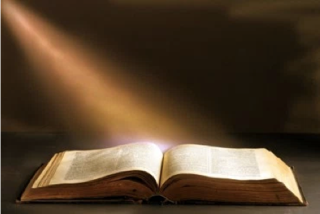
Jordan is where the greatest Bible events took place! See the land of Genesis in the Jordan Valley, the place of God’s creation and the spiritual area of God’s covenants with mankind; travel on the Kings Highway, the world’s oldest continuously used communication route; see Noah’s tomb and follow the adventures of Abraham as he travelled through Jordan, where God first interacted with man and appeared many times.
Through Job, Jordan witnessed the earliest human movement towards monotheism; Experience the ancient Biblical Kingdoms of Edom, Moab and Ammon; Where God protected Lot, as he fled from Sodom and was sheltered in a cave; where Jacob and Esau made their pact, Jacob, as he wrestled with an angel by the Jabbock River; and Moses, as he led the great Exodus northwards from Aqaba. There’s Mount Hor, where Aaron died and was buried; the plains of Moab, where Moses gave his final instructions and blessing; Beth Peor, where he pleaded with God to be allowed to enter the Promised Land; Mount Nebo, where he glimpsed it and died; Experience the oldest mosaics in the world; See the Decapolis city of Jerash; Learn where Joshua crossed the Jordan River; Elijah’s homeland, his tomb and his ascension to Heaven; See the magnificent city of Petra, where the wise men brought their gifts to baby Jesus.
At Bethany Beyond the Jordan, where Elisha cured the leper in the waters of the Jordan River, where John preached and baptized Jesus, where the Holy Trinity occurred and Christianity was born; where Jesus was tempted in the wilderness and met his first disciples; See Perea where Jesus preached, performed many miracles and healed the sick; at Machaerus, where John was beheaded at Herod’s fortress. Learn about the tombs in Umm Qais, which the Gadarene demoniac frequented and Jesus shared many parables with his followers; In Jordan, where the first Christians fled from Jerusalem; the earliest ever churches were built; the land of peace and refuge and where the Second Coming of Jesus will occur as recorded in the Bible. In Jordan the Bible comes alive.
The Hashemite Kingdom of Jordan is a rich Biblical land and the central part of the Holy Land where the pages of the Bible come alive. Jordan has witnessed the unfolding of God’s salvation dating back to God’s creation as recorded in the Bible. Numerous interpretations claim that the Garden of Eden was located in the Jordan Valley and the story of Adam and Eve was located in an area along the northeast bank of the River Jordan. (Genesis 13:10) Peace River Jordan invites you to Jordan which is placed firmly in the genesis of human faith on earth, to experience Jordan’s ancient rich archeological and Biblical legacy.
God has granted Jordan with many special sites, It is here in Jordan where God first manifested Himself to man through the words of Abraham, Job, Jacob, Moses, Elijah, Elisha and Jesus, appearing to them in the form of whirlwinds, a cloud of light, an angel, or a voice that commanded them to do his will. Such Biblical figures are closely connected to the Jordan River; and Jordan is the only place where their Biblical lives are closely connected. Jordan is an ancient Biblical land that offers spiritual contemplation and worship and a place to receive blessings from the earth and the water of this uniquely blessed land, the home of the original Christians.
God has graced Jordan as a land of peace and refuge many times throughout the lives of Elijah, David, Jesus, John the Baptist and others. Jordan was also the place of refuge, safety and peace for the first Christian communities who left Jerusalem in the first century, and fled to beyond the Jordan River and settled in Pella in northern Jordan. The land of Jordan will always be peaceful as decreed by God, as Jordan is the one place that will not be overcome, as satated in the Bible “….He will also invade the Beautiful Land. Many countries will fall, but Edom, Moab and the leaders of Ammon (Present day Jordan) will be delivered from his hand.” (Daniel 11:41)
Those seeking refuge and peace in Jerusalem during the second half of the tribulation period, will not find a safe place to hide anywhere on the earth, except the refuge that God has provided, the mountains in the rose red city of Petra in modern Jordan. (Matthew 24:19) As a testament to the importance of Jordan in the Biblical world, and of importance to all Christians worldwide, the Messiah, as decreed in the Bible will return to earth and will appear in the ancient city of Bozrah, an Edomite capital in southern Jordan. (Isaiah 63:1; Revelations 19:13)
The Jordan River, the world’s most sacred river, plays an important role in the Bible where it is mentioned 190 times and is where John the Baptist’s baptism of Jesus occurred and marks the defining moment of the birth of Christianity. It is not only the site of Jesus’ Baptism and the site where the Holy Trinity occurred, but most importantly where Christianity began, identifying Jesus as the Messiah with the presence of the Holy Spirit, making it the most sacred, spiritual and important place on earth, the spiritual heartland of Christianity and one of the holiest places in Christianity.
Perhaps more than any other river, the Jordan River has captured the hearts and minds of millions of people around the world. Today the Jordan River continues to flow as it has for thousands of years, bringing water from the northern mountains to the Sea of Galilee. The river then flows southward from the Sea of Galilee to the Dead Sea, where pilgrims and tourists come in great numbers from different denominations and faiths who seek infinite blessings, spirituality and comfort from a land graced by the great prophets, saints and the Messiah.
The Jordan River, the River of baptism and spiritual cleansing was the location of many Biblical miracles culminating in the most momentous Biblical event, the Baptism of Jesus by John the Baptist. It was in Jordan at the Jordan River that Jesus was announced as the Messiah. His ministry was inaugurated, where the Holy Trinity was completed and God s voice was heard on earth. Jesus was taken to the wilderness in Jordan, He chose his first disciples, first prayed to God, began preaching about the Kingdom of God often in the form of parables, where he healed the sick and performed many miracles, all which occurred in the ancient Biblical land of Jordan.
It has since biblical times been imbued with powerful symbolic meanings, has witnessed many miracles, is a boundary and a crossing point, and a metaphor for spiritual rebirth, salvation and a source of the precious Holy Water in which Jesus was Baptized. ‘Bethany Beyond the Jordan, where the Jordan River is located, is a place of eminent spiritual and historical importance and a profound place of peace.
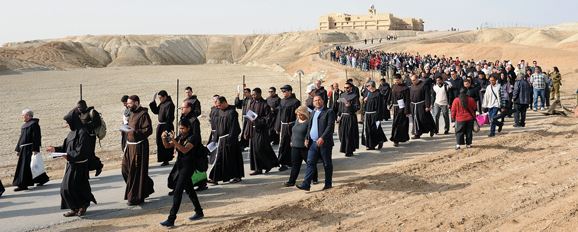
‘Having been to the Jordan River, I can say that there is a sense of God’s energy, God’s grace which is focused in those places and in a particularly powerful way.’ These were the words spoken by Rev. Canon Charles Gibbs, Episcopal Priest and Executive Director, United Religions Initiative, on his visit to the Jordan River.
The spiritual dimension of the Jordan River is infinite, and since biblical times it has witnessed powerful miracles and has a ‘life’ of its own, as if it were ‘a haven of the Holy Spirit,’ which bestows blessings and revives those who believe in Christ. The Jordan River is a special place for spiritual contemplation and worship, and the faithful make pilgrimages to the Jordan River, where they encounter Holy Spirit and walk the paths where Jesus walked and receive blessings from the precious Holy Water of the Jordan River.
The Jordan River is the source of all Holy Water in Christianity where the sacrament of Jesus’ Baptism occurred, and where the miraculous presence of the Holy Spirit and the opening of the heavens occurred completing the Holy Trinity, blessing the waters of the Jordan River which changed its natural properties. Through Holy Water, God’s grace is communicated to man in an invisible, but most profound way. In the use of precious Holy Water, God’s powerful presence is offered to us and he touches our very being, healing us and reconciling us with Him in the very waters that He was Baptized in.
Many people who visit the Jordan River are overcome with emotion being at the very site of Jesus’ Baptism, where the Messiah arose out of the water, and where the Ministry of Jesus began and God’s voice was heard on earth, completing the Holy Trinity. Many visitors comment on the divine spirituality and overwhelming serenity experienced at the Jordan River which is is unparalleled anywhere else on earth. The Jordan River is a sacred religious site which offers its visitors tranquility, peace and an aura of calmness.
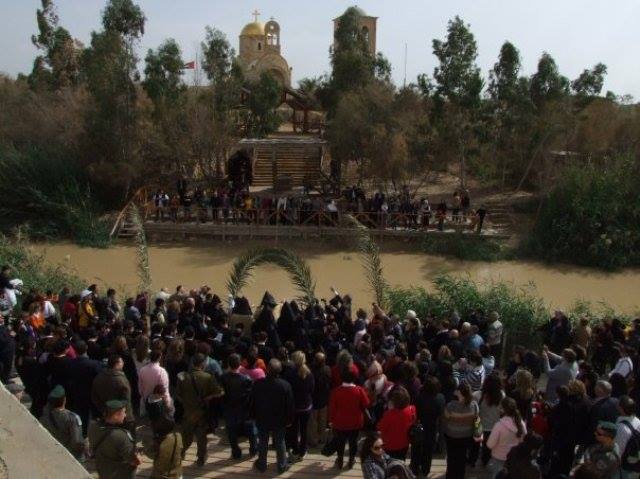
In describing the Jordan River, Metropolitan Kallistos of Diokleia, Lecturer in Eastern Orthodox studies at the University of Oxford said, ‘There are certain places on Earth where God’s presence is experienced with a special power of immediacy, what we might call thin places, where the wall of partition between the visible and invisible world grows transparent points in a sacred space.’
At the Jordan River the pages of the Bible come alive and transform into a breathing living world where you can touch and walk along the paths tread by the prophets, including Jesus Christ, John the Baptist, Elijah, Elisha and Joshua, and experience the Biblical dimension found at the Jordan River.
Biblical Miracles at the Jordan River
The beauty of the Jordan River flows through the Old and New Testaments in the Bible where it is mentioned 190 times, strongly stating its significance and foreshadows the coming of the Messiah and John’s baptism of Jesus Christ, ‘By the way of the sea, beyond Jordan, in Galilee of the nations.’ (Isaiah 9:1–2) Even before the most momentous event of the Baptism of Jesus, the Jordan River witnessed prophets, and Biblical miracles showing us the importance of the Jordan River.
In Genesis, the opening chapter of the Bible, the Jordan River is described as the, ‘Garden of God.’ as clearly stated, ‘Lot looked around and saw that the whole plain of the Jordan toward Zoar was well watered, like the garden of the LORD. (Genesis 13:10).
It tells us of the story of the separation of Abraham and Lot and Lot’s decision to settle in the plain of the Jordan Valley. The entire valley between the Sea of Galilee and the Dead Sea along the Jordan River seemed to Lot like the Garden of Eden, or at least a lush oasis. Lot chose the fertile cities of Sodom and Gomorrah in the southern Jordan Valley as his new homeland. The second mention of the Jordan River is also in Genesis (32:11). Here Jacob speaks of crossing the Jordan River to go to his mother’s people in Padan Aram.
Jacob passed over the Jabbok River a tributary of the Jordan River and it was there that he wrestled with an Angel. The Angel asked him his name and he replied, Jacob. Then the Angel told him, ‘Thy name shall be called no more Jacob, but Israel, for as a prince hast thou power with God and with men, and hast prevailed.’ (Genesis 32:22-28) The Jordan River is mentioned again for the third time in Genesis (50:10), which tells us of Joseph and the Egyptians mourning for Jacob who was buried, on the east side of Jordan, the site of Jesus’ Baptism.
Ezekiel describes the Jordan River as a new river of life that will begin at the Temple threshold, flowing into and restoring the Dead Sea, which is fed by the Jordan River. ‘When it empties into the sea, the salty water there becomes fresh. Swarms of living creatures will live wherever the river flows. Fishermen will stand along the shore; from En Gedi to En Eglaim, there will be places for spreading nets. Fruit trees of all kinds will grow on both banks of the river. Every month they will bear fruit, because the water from the sanctuary flows to them. Their fruit will serve for food and their leaves for healing’ (Ezekiel 47:8-12).
The Book of Revelation describes the Jordan River as, ‘The river of the water of life, clear as crystal, flowing from the throne of God’ and the Lamb.’ (Revelation 22:1–2) Even before the Baptism of Jesus, the Jordan River witnessed miracles document in the Bible. The Jordan River miraculously parted three times revealing the dry Jordan River bed.
The first parting of the Jordan River was experienced by Joshua who led the Israelites to the Promised Land. He told the Israelites that the Lord will do amazing things and they should prepare themselves for the next day when they would travel across the Jordan River. On the day of the crossing, the Israelites were led by the priests who were carrying the Arc of the Covenant. As soon as the priests reached the bank of the Jordan River, they stepped into the Jordan River and immediately and miraculously the water stopped flowing and piled up like a wall and the water flowing to the Sea of the Arabah, now the Dead Sea, was completely cut off.
Joshua led the Israelites and the priests carrying the Arc of the Covenant across the dry Jordan River bed. Joshua also told twelve men, one from each tribe, to get a stone from the middle of the dry river bed and carry it to the other side where they would put all the stones together as a sign so that they could tell their children that, ‘The flow of the Jordan River was cut off to allow the Arc of the Covenant to pass into the Promised Land and the stones were to be a memorial.’ (Joshua 4:6).
The second time that the Jordan River parted was when Elijah and Elisha also crossed the Jordan River. Elijah told Elisha, ‘Stay here the Lord has sent me to the Jordan River,’ (2 Kings 2:6-7). Elijah took his cloak and struck the water of the Jordan River with it and the water divided left and right allowing both Elijah and Elisha to cross the River Jordan on dry ground. After crossing to the Promised Land a ‘chariot of fire’ appeared and Elijah went in a whirlwind up to heaven from the Baptism site of Jesus. (2 Kings 2:8-11).
The Jordan River miraculously parted for the third and final time to reveal dry ground, allowing it to be crossed by Elisha. When Elijah dropped his cloak, Elisha grabbed it and struck the water in the Jordan River with Elijah s cloak and cried out, ‘Where is the LORD, the God of Elijah?’ (2 Kings 2:14). The Jordan River divided right and left allowing Elisha to cross the Jordan River on dry ground once again.
A further miracle that occurred at the Jordan River was experienced again by Elisha who was building a house by the Jordan River. As they were cutting trees, an axe head fell into the Jordan River and Elisha asked where it fell. The man who dropped the axe in the river showed Elisha where it fell and Elisha threw a stick into the Jordan River and this made the iron axe head float on top of the Jordan River. Elisha said, ‘Take it up’ so the man reached out his hand and took it. (2 Kings 6:1-6).
The miraculous healing properties of the Jordan River was witnessed in the cleansing of Naaman, an army general, who was miraculously healed from leprosy in the Jordan River. Elisha instructed him to wash himself seven times in the Jordan River. ‘So he went down and dipped himself in the Jordan seven times, as the man of God told him, and his flesh was restored and became clean like that of a young boy.’ (2 Kings 5:1-14) Namaan cleansing his leprosy, points to the inward healing of our souls in Baptism from the leprosy of sin and the powerful, cleansing nature of Holy Water.
It is interesting that the Jordan River witnessed such beautiful Biblical events showing us the importance of the Jordan River which culminated in the biggest event of them all, the Baptism of Jesus at the Jordan River. To read about the Baptism of Jesus at the Jordan River click here. The Bible also tells us of the significance of the Jordan River during Jesus’ Ministry and the times that Jesus spent at the Jordan River, when Jesus preached, and when he crossed the Jordan River. (Matthew 19:1, Mark 10:1)
The Bible also documents the believers crossing the Jordan River to hear Jesus preach and to be healed from their diseases, ‘Large crowds from Galilee, the Decapolis, Jerusalem, Ju-dea and the region across the Jordan followed him.’ (Matthew 4:25). When Jesus’ ene-mies sought to capture Him, he took refuge at the Jordan River. ‘Then Jesus went back across the Jordan to the place where John had been baptizing in the early days……. and in that place many believed in Jesus.’ (John 10:40).
The History of the Jordan River
Many Believers seeking to deepen their understanding of the Bible and follow in the footsteps of Jesus visit the Jordan River, to touch the only remaining substance that Jesus touched. The Jordan River is a river of rich historical and spiritual significance. From its sources on the slopes of Mount Hermon, the Jordan River winds its way through the Jordan River Valley over a distance of about 225 km to discharge into the Dead Sea, the lowest point on earth at below 422 meters. Below is a brief history of the Jordan River detailing its significance since the time of Jesus’ Baptism to the modern day.
The Jordan River has for centuries attracted pilgrims from across the world who have travelled long distances to immerse themselves in the Jordan River where Jesus’ Baptism altered the spiritual status of the water of the Jordan River. Today almost a million visitors annually make the pilgrimage the Baptism Site to follow in the footsteps of Jesus Christ.
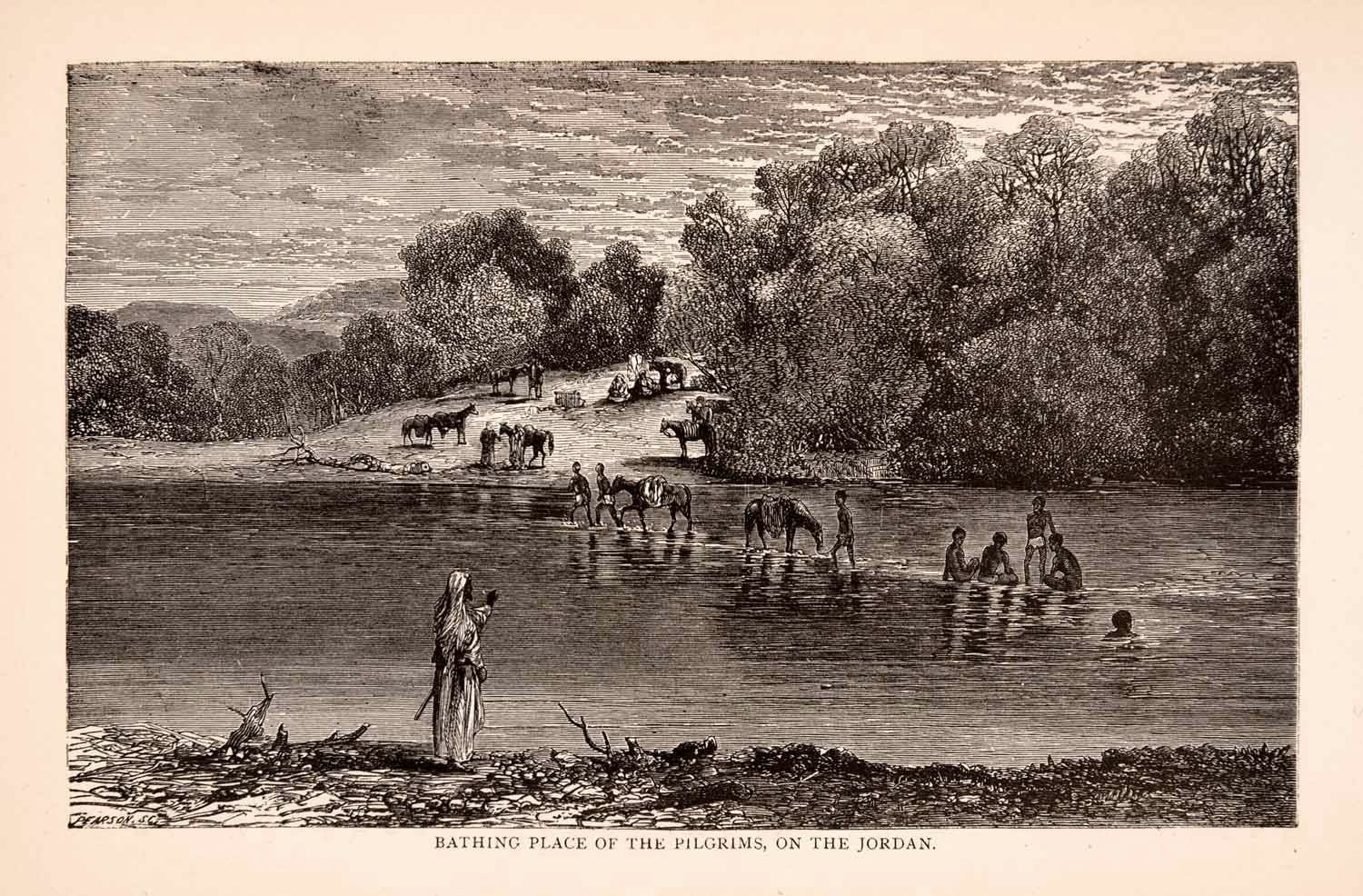
Russian pilgrims at the Jordan. Source: Catalogue of photographs made by the American Colony (1898-1914).
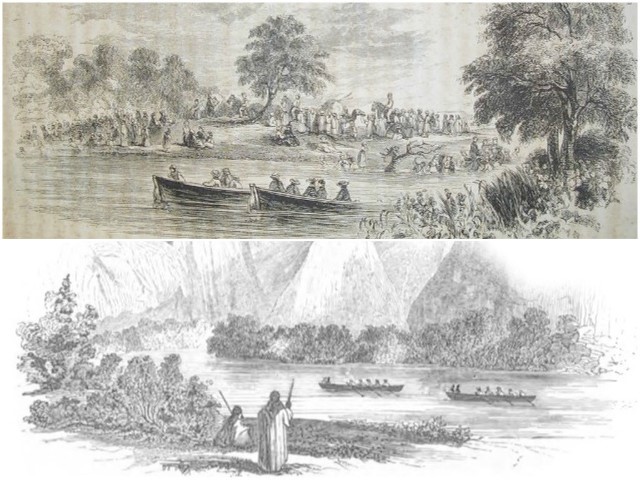
Views of the Jordan River in the seventeenth century. Above: Pilgrims bathing in the Jordan River.
Bottom: Scene on the Jordan River. Source: Lynch, 1853
At the Baptism Site a 3rd century Roman building was discovered, decorated with mosaics, and is believed to be an early Christian ‘Prayer Hall’ which is believed to be the ear-liest building used for prayer in the world. Close to the Jordan River are the remains of five memorial churches, built by early believers in the memory of the Baptism of Jesus. It is also the site of the celestial ascension of the prophet Elijah, the hermit cells, the pilgrims station, and the wilderness of John the Baptist, which remains untouched to this day, from the time of Jesus’ Baptism and His mission on earth.
The site where John the Baptist baptized Jesus in the Jordan River became an important pilgrimage site from the 4th century. Several historical writers recorded their visits at the Jordan River, including the 6th century geographer Theodosius, who described a marble column topped by an iron cross that had been erected at the place where Jesus was thought to have been Baptized. He also wrote about the Church of St. John the Baptist, built by the Emperor Anastasius, which ‘stands on great vaults which are high enough for the times when the Jordan is in flood.’
The sick and disabled came to the Jordan River for healing, as Jacinthus the Presbyter related in the late 11th century. He wrote, ‘On the feast of the Epiphany cripples and sick people come and, using the rope to steady themselves, go down to dip themselves in the water. Women who are barren also come here.’ For those who were too sick to make the journey, water could also be drawn from the Jordan River and brought to them.
By the late Middle Ages, the Jordan River was venerated almost exclusively as a relic of Jesus Christ, possessing powerful spiritual forces. A late 13th century guidebook gave just one reason for immersion in the Jordan River, ‘These are the waters which came into contact with the body of Christ, our Redeemer.’ The 17th-century English cleric, Henry Maundrell described how pilgrims also cut branches off the reeds on the riverbanks, while later accounts by 19th century Russian travelers described pilgrims taking bottles of holy water and burial shrouds dipped in the Jordan River, home with them.
The Baptism Site was largely abandoned after World War I and became part of an inaccessible military zone after the 1967 Six Day War in Jordan. After Jordan signed a peace treaty in 1994, the area was demined and ‘rediscovered.’
Extensive archaeological work in Jordan has uncovered a series of churches, monasteries and other remains, including the church described by Theodosius in the 6th century. One excavation revealed remnants of a third century church with a cruciform baptismal structure where early pilgrims came to be baptized. Carved into the stone are thousands of small crosses, signs early Christians would leave after being baptized. Another dig has unearthed what is believed to be the cave where John the Baptist lived. Together with further textual references, these archaeological finds have led the Jordanian authorities to declare this to be the authentic Baptism Site of Jesus Christ, as confirmed by UNESCO, as a World Heritage Site in 2015.
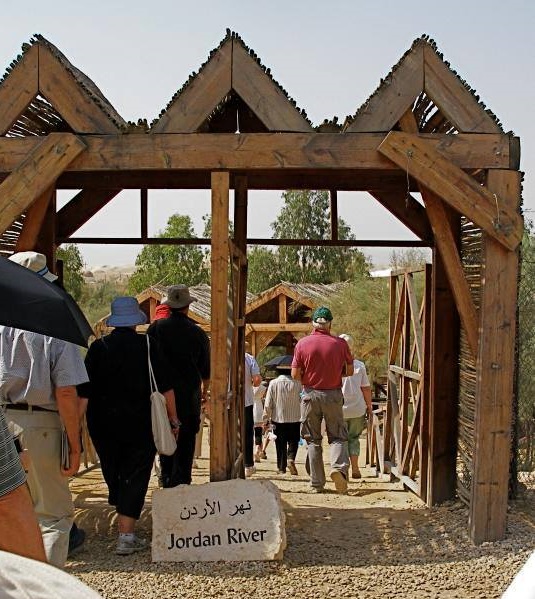
Today owing to overwhelming biblical, archaeological, and historical evidence, the precise location of Jesus Christ’s baptism is found to the east of the Jordan River. This is further confirmed by a series of letters of authentication,’ personal endorsements and visits by World Church Leaders including Pope Francis in May 2014. To read more about Pope Francis’ historic visit to the Jordan River click here. Prior to Pope Francis’ visit to the Jordan River pilgrimages have been made by previous Catholic Popes in-cluding Pope John Paul II who visited the Baptism Site in March 2000 and Pope Bene-dict XVI who visited the Baptism Site in May 2009. The Egyptian Pope, the Patriarch of Moscow, numerous World and Royal figures, heads of state, and other important digni-taries have also made special pilgrimages to the Holy Land. To read about our World leader, Peace River Jordan endorsements and more about these special visits to the Jordan River click here.
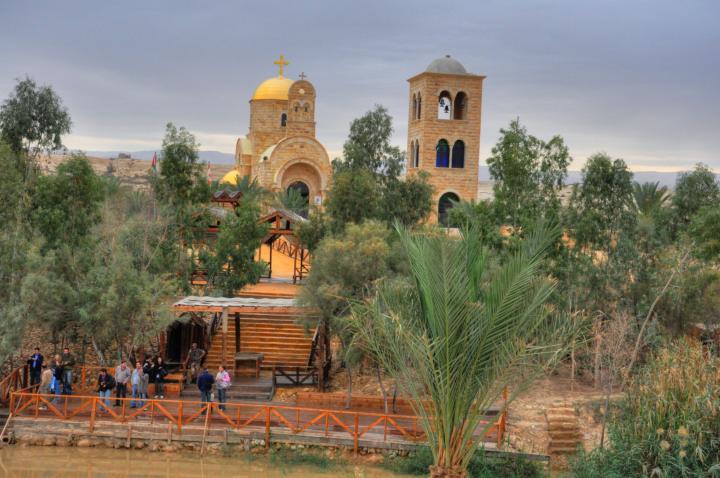
Moreover, the Jordanian government has donated national land for the establishment of 12 churches of different denominations at the Baptism site, which adds a layer of modern mythology to the layers of biblical, archaeological, and historical mythology. The Baptism Site Commission is dedicated in keeping the site as natural as possible and today remains the same natural wilderness where Jesus walked.
Today the Jordan River has captured the hearts and minds of millions of people around the world, and it continues to flow today just as it flowed for thousands of years, witnessing immense biblical history, profound miracles, the Holy Trinity, blessings of Jesus and the site where God’s voice was heard on Earth. The Jordan River runs today as the most spiritual serene biblical site which is unparalleled anywhere else on earth. The Peace River Jordan Team are committed in bringing you a part of the spirituality found at the Jordan River by distributing the blessed Holy Water from the Jordan River, the ‘Gift of Peace’ for all those who are unable visit, and experience the site of Jesus’ Baptism, most spiritual place on earth, the Jordan River.
